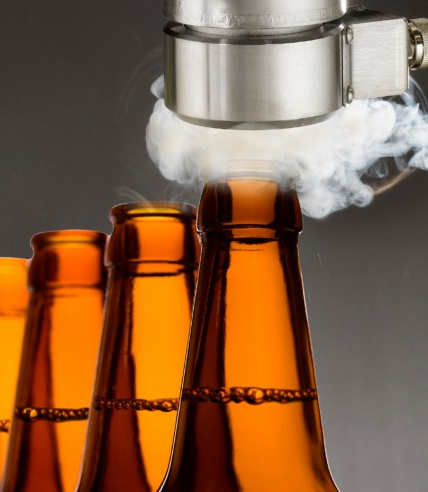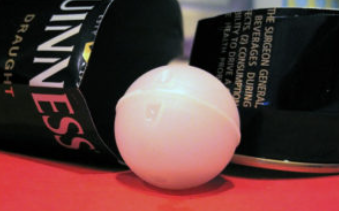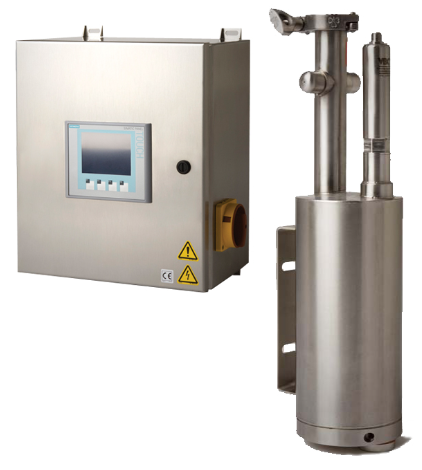Liquid nitrogen dispensers of the company Vacuum Barrier Systems
Today, nitrogen is in demand in many industries. In mechanical engineering, it is required for various high-temperature metal processing processes. The pharmaceutical industry uses it to preserve blood and other blood-containing products. In the food industry, nitrogen in liquid and gaseous form is used for packaging, freezing, transporting and storing food products.
Liquid nitrogen is used to create an inert environment, which is necessary for bottling beverages to ensure that the products meet the requirements of product quality standards in terms of taste, smell, carbonation, as well as safe storage and packaging. Filling containers with this substance helps to extend the shelf life of products. In addition, nitrogen is sometimes used to dry bottles after washing. Some beverages contain various ingredients that are very sensitive to oxidation. This is evidenced by changes in the desired bouquet, colour and rich flavour of the product that occur during storage. Only a small amount of oxygen dissolved in the beverage causes these changes. Regardless of the type of packaging chosen, a simple drop of rapidly expanding liquid nitrogen can keep the dissolved oxygen content to a minimum. Whether inerting before filling or injecting into the space under the cap, either method reduces the oxygen content, allowing you to enjoy the original flavour of the product. These technologies are used for still beverages, wine, oil, juices, beer, etc.
Nitrogen beer as a taste test
Nitrogen beer is becoming increasingly popular around the world every year. Many gourmets of frothy alcohol consider it a benchmark that other beer producers should strive for. But all this is there, outside our country. And here in Ukraine, people are very sceptical about various progressive innovations.
 Today, the most common nitrogen beer is Guinness Draught. It is served carbonated not with carbon dioxide (as usual), but with a nitrogen mixture (approximately 70% N2 and 30% CO2). A plastic capsule with nitrogen (a widget) is placed inside the can. When opened, the internal pressure in the capsule drops sharply, as a result, nitrogen escapes from the capsule, saturating the beer and creating a dense foam cap, and the beer itself gets a soft creamy consistency. It is very important to pour the beer into a glass as quickly as possible. By the way, it's not necessary to pour over the wall, as the foam is formed in a completely different way. Only recently, a couple of small breweries in the US have been able to start bottling craft beer in nitrogen bottles without "widgets". Thanks to liquid nitrogen dispensers from Vacuum Barrier Systems , this daunting task has become possible.
Today, the most common nitrogen beer is Guinness Draught. It is served carbonated not with carbon dioxide (as usual), but with a nitrogen mixture (approximately 70% N2 and 30% CO2). A plastic capsule with nitrogen (a widget) is placed inside the can. When opened, the internal pressure in the capsule drops sharply, as a result, nitrogen escapes from the capsule, saturating the beer and creating a dense foam cap, and the beer itself gets a soft creamy consistency. It is very important to pour the beer into a glass as quickly as possible. By the way, it's not necessary to pour over the wall, as the foam is formed in a completely different way. Only recently, a couple of small breweries in the US have been able to start bottling craft beer in nitrogen bottles without "widgets". Thanks to liquid nitrogen dispensers from Vacuum Barrier Systems , this daunting task has become possible.
The dispenser itself is a fully automatic device made of stainless steel with a flexible vacuum hose connected to a liquid nitrogen source; a control panel; a container sensor that prevents dispensing past the bottle and a speed sensor that monitors the strokes of the machines. If necessary, the sensor sends a signal to the control panel, and the dispenser changes the dosing frequency and the opening time of the dosing valve. The entire system is located directly in the filling line or on a mobile bed.
Dosing is no different than usual: after the beer has been bottled or canned, liquid nitrogen is injected into the free space above the product at precisely defined intervals to create an internal pressure of at least 2 bar.Just one drop of liquid nitrogen dosed into the container turns into 850 ml of gaseous nitrogen at room temperature.
However, the dosing of liquid nitrogen is only the "finishing touch". The above is only true if there is a complete absence of oxygen. Due to the fact that oxidation reactions can occur during storage or mixing of products, it is necessary to inert tanks and containers. This is a kind of filling the surface above the liquid in the container with an inert gas during storage or emptying. It is also necessary to ensure that the carbon dioxide supply is accurately calculated to ensure the required quality and degree of carbonation of the beverage. Furthermore, the beer must be saturated with nitrogen gas or beer gas (mixture of N2 and CO2) so that it is completely dissolved in the beer.
Liquid nitrogen supply systems from the company Vacuum Barrier Systems operate without ice formation and ensure accurate dosing at all line speeds. The high level of accuracy and reliability helps to reduce downtime and maximise the productivity of filling lines.
To purchase a Vacuum Barrier Systems dispenser, please call Tel: +38 (044) 390-73-38
E-mail: info@steiner.com.ua

